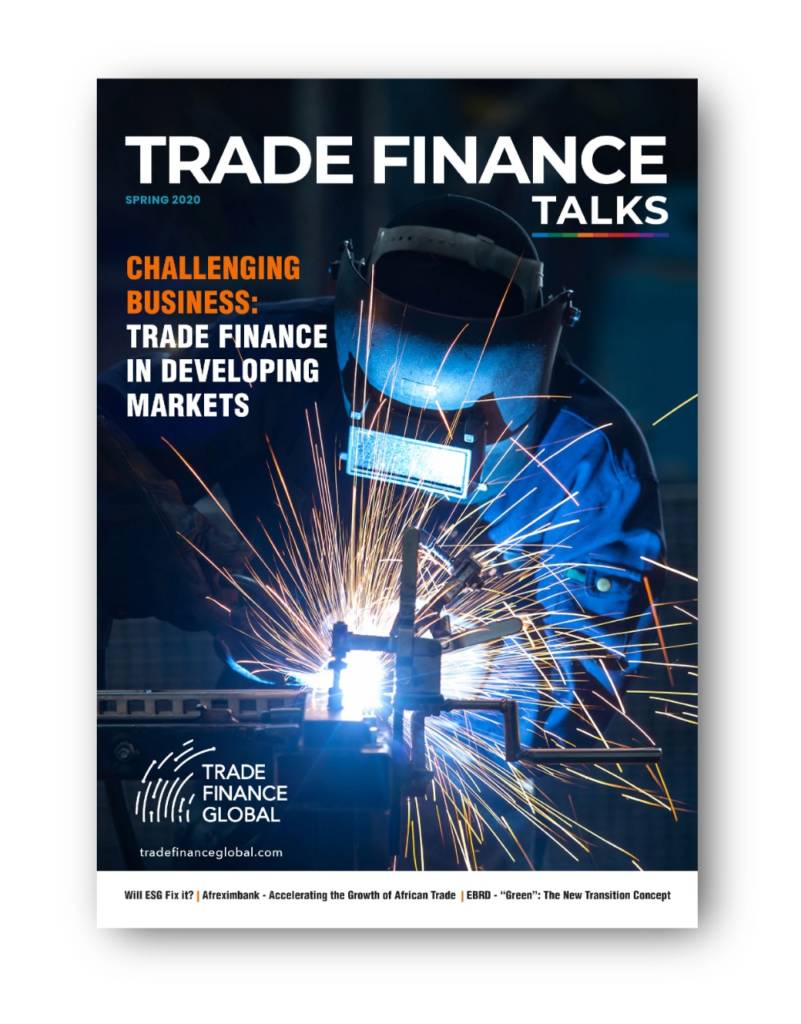The CEE/CIS region continues to offer plenty of both opportunities and challenges for banks. TFG spoke to Elitza Kavrakova, Head of Institutional Clients East, and Martina Zimmerl, Head of Trade Finance, at Raiffeisen Bank International AG.
The CEE/CIS region continues to offer plenty of both opportunities and challenges for banks. TFG’s Persiana Ignatova spoke to Elitza Kavrakova, Head of Institutional Clients East, and Martina Zimmerl, Head of Trade Finance, at Vienna-based Raiffeisen Bank International AG about the region and why RBI remains successful there.
Persiana Ignatova: Can you give us a brief overview of the economic and geopolitical situation in the CEE/CIS region?
Elitza Kavrakova: For the Central and Southeastern European countries closer to the EU, the last few years have been rather successful, with average GDP growth in most cases above 3%. Therefore, the region consistently beats the euro area growth rate, i.e. the real convergence process is well on track there. Going forward we see economic growth well anchored in the 2-3% range there. Currently, the economic momentum in the CE/SEE region is largely driven by solid domestic economic conditions, based on a healthy private and public sector balance sheet. Nevertheless, we expect a certain growth moderation based on structural factors (e.g. tight labour markets, lower EU funding). However, this should be healthy given the increasingly tight labour markets as well as some signs of overheating in certain sector (e.g. real estate). In the CIS region, the last few years have been more disappointing economically, given sanctions and the oil price shock as well as regional tensions and conflicts. However, we currently see a good recovery potential: Ukraine is one of the most promising turn-around stories in CEE. Here we see a strong change momentum, mostly driven by fresh and reform-oriented elites. A somewhat similar development we see also in Uzbekistan. Moreover, we see a turn to more growth-friendly policies in Russia. One should not forget that the latter remains one of the most solid Emerging Market economies globally from a macro-financial perspective. We also see a broader turn to prudent macro-economic policies in many other CIS countries in recent years (e.g. Belarus, Kazakhstan, Azerbaijan, Uzbekistan, Turkmenistan). And we expect higher chances for certain progress in the conflict Ukraine/Russia rather than another round of escalation. Therefore, we do not see that relations between the West and Russia will further deteriorate, and there is even some potential for rapprochement between the EU and Russia in case the situation in Ukraine should further stabilize.
PI: How do correspondent banks work with multilateral development banks such as EBRD/ADB in this region and how does this affect access to trade finance in CEE?
EK: RBI, as one of the few remaining EU banks keeping a larger correspondent network in the CEE/CIS region, works closely with multilateral development banks and IFIs like EBRD, IFC and ADB. On the one hand, we are delighted to act as a confirming bank under their trade facilitation programmes, which allows us to support local banks and their importing clients better. On the other hand, we keep a regular dialogue with these institutions, which are also shareholders in CEE/CIS banks, as this is an important factor for improving risk and compliance governance locally. While in all CEE/CIS countries banks are aware of the increased AML/CTF requirements of Western correspondents, the same cannot be said for the local regulators, who of course may have a specific view stemming from the current needs of the local economy (for example granting easy access to a bank account to everybody). Establishing a regular dialogue with the local regulators and supporting them as well as the local banks in building up expertise and necessary governance and compliance capacity is essential and something RBI started doing particularly in the CIS a while ago, thereby supporting the efforts of the multilateral development banks.

PI: What is the size of the trade finance market in the CEE and CIS region, and do you believe that this is a risky market?
MZ: The size of the trade finance market is difficult to assess due to lack of data. The latest ICC trade finance survey estimates the total volume of traditional trade finance instruments issued and received in the region at nearly USD 300 bn. This region is home to the RBI Group – we know the players and the market very well and feel comfortable with the risk. This comfort is supported by the fact that we’ve had no major losses in trade finance in this region since 2010. So, counterparty risk is not an issue for us.
EK: The main challenges currently are rather driven by geopolitical events and the danger of any type of new sanctions. That means that the unpredictability of events often leads to reduced risk-taking appetite also on the Trade Finance side, e.g. to restrictions in terms of counterparty or country limits, tenors or client segments.
PI: As a result of increasing costs from regulation, are trade finance margins becoming smaller for the bank?
MZ: The juicy days are definitely over. Following the Russian and Ukrainian sanctions, the trade finance market has contracted and hasn’t fully recovered to its original levels. At the same time, only few Western banks active in trade finance have left the region because of sanctions. So, the overall cake has become smaller whereas the appetite for CIS risk has not decreased considerably. At the same time, the cost of compliance for Western banks increased over the last five years. Trade finance margins have therefore certainly decreased.
PI: What are the challenges and where do you see opportunities in for the trade, treasury and payments sector?
EK: As mentioned before – the biggest challenges for these sectors are:
Global geopolitical developments
It has become inevitable for us to follow the daily news, to try to understand the next big moves that may influence political developments and – as a consequence – the economic situation in the emerging markets. In this context it is of utmost importance that we are quick and good at assessing objectively what is really going on in order to react properly in terms of credit risks and compliance (non-financial) risks
Compliance
This topic continues to be one of our main challenges. First of all, because of regulatory requirements, which can be only partially supported by joint KYC platforms available already. Most of the CEE/CIS banks keeping correspondent relationships with Western and US banks are well aware of the level of scrutiny applied regarding AML/CTF. However, in many countries the local legislation is de facto lagging behind the Western requirements, that means the local banks are put in a situation in which they are required by Western banks to do more than their local law/regulator requires from them. The same is true in certain cases for shareholders / beneficial owners of local banks – not always their understanding for the necessity to provide KYC documents in required quality on time is given. What also needs to be mentioned is the necessity to build up an understanding of material compliance checks versus the fulfillment of formal legal requirements. This requires the support from IFIs and major correspondent banks such as RBI for building up local expertise.
Cross-selling
What we mean by that is the possibility for smaller emerging market players to deliver ancillary business. Due to increased risk and compliance costs Western banks have much higher profitability requirements on the client/counterparty level. For many players in smaller economies these are hard to fulfill today, or to assure sufficient cross-selling to their Western correspondents.

MZ: Despite all these challenges, we continue to see plenty of opportunities in the region: The global economy cannot function without trade and related payments, this means that these sectors will continue to exist, and they need to be serviced. Payments and trade finance will remain our sustainable bread-and-butter business with very low loss rates. We see system enhancements and process automatization in all three sectors. On the one hand, we create customer experience and additional value for our clients by digitizing the way they interact with us. On the other hand, automation and big data analytics support us in early detection and reduction of both counterparty and compliance risks. Change of trade flows, for example driven by geopolitical events, still offer plenty of opportunities for exploring new markets and counterparties. So, the challenges mentioned by Elitza above at the same time are our opportunities on the trade finance side because – if you understand how to navigate stormy waters – you are also able to take risks others are not ready to take.
PI: With increasing tenors in the market, particularly around discounted Letter of Credit transactions, do you see an evolution of short tenor trade finance towards project and export finance?
MZ: In some of the CIS markets we see a tendency towards very long L/C discounting tenors, particularly when heavy machinery or equipment is imported. In such cases, the issuing banks should question whether a deferred payment letter of credit is indeed the right financing instrument or whether it wouldn’t be more prudent, both from the regulatory and the counterparty risk point of view, to structure the transaction as a loan or even as a project finance deal. I see the risk that letters of credit that should primarily serve as risk mitigation in international trade are misused for financing purposes where probably other types of financings would be more appropriate.
Now launched! Spring Edition 2020
Trade Finance Global’s latest edition of Trade Finance Talks is now out, taking a deep dive into trade finance in emerging and developing markets.




























